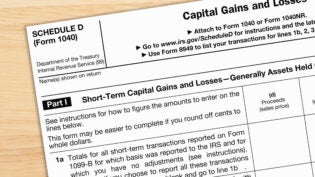The Sale of Business or Investment Property: Several Ways to Defer the Tax on Gains
By: TaxConnections

When a sale of a business or investment property results in a gain, the seller is typically taxed on that gain during the year of the sale, even when the gain was generated over many years. However, the tax code provides opportunities to spread this gain over several years, to postpone it by deferring the gain into another property, or to simply defer it for a specified period of time. These arrangements can be accomplished by selling the property in an installment sale, by exchanging the property for another, or by investing in a qualified opportunity fund. As with all tax strategies, these options have unique requirements. The following is an overview of what tax law says about these strategies.
Tax-Deferred Exchange – Many people refer to this arrangement as a “tax-free exchange,” but the gain is not actually tax-free; rather, it is deferred into another property. The gain will eventually be taxed when that property is sold (or will be deferred again in another exchange). These arrangements are also known as “1031 exchanges,” in reference to the tax code section that authorizes them: IRC Sec. 1031.
In the past, these exchanges applied to all properties, but since 2017, they have only applied to business- or investment-related exchanges of real estate. One of the requirements is that the exchanges must involve like-kind properties. However, the tax regulations for real estate exchanges are very liberal, and virtually any property can be exchanged for any other, regardless of whether they are improved or unimproved. One exception to this rule is that U.S. property cannot be exchanged for foreign property.
Exchange treatment is not optional; if an exchange meets the requirements of Sec. 1031, the gain must be deferred. Thus, taxpayers who do not wish to defer gains should avoid using an exchange.
It is almost impossible to for an exchange to be simultaneous, so the tax code permits delayed exchanges. Although such exchanges have other requirements, they generally involve a replacement property (or properties) that is identified within 45 days and acquired within 180 days or the tax-return due date (including extensions) for the year when the original property was transferred—whichever is sooner. An exchange accommodator typically holds the proceeds from such exchanges until they can be completed.
The tax code also permits reverse exchanges, in which an exchange accommodator holds the replacement property’s title until the exchange can be completed. The other exchange property must be identified within 45 days, and the transaction must be completed within 180 days of the sale of the original property.
The amount of gain that is deferred using the exchange method depends on the properties’ fair-market values and mortgage amounts, as well as on whether an unlike property (boot) is involved in the exchange. The rule of thumb is that the exchange is more likely to be fully tax deferred when the properties have greater value and equity.
Installment Sale – In an installment sale, the property’s seller provides a loan to the buyer. The seller then only pays income taxes only on the portion of the taxable gains that occur during the year of the sale; this includes the down payment and any other principal payments received in that year. The seller then collects interest on the loan at rates approaching those that banks charge. Each year, the seller pays tax on the interest and the taxable portion of the principal payments received in that year. For a sale to qualify as an installment sale, the seller must receive at least one payment after the year when the sale occurs. Installment sales are most frequently used for real estate; they cannot be used for the sale of publicly traded stock or securities. The installment sale provisions also do not apply when the sale results in a tax loss.
If the sold property is mortgaged, the mortgage must be paid off as part of the sale. Even if the seller does not have the financial resources to pay off the existing loan, an installment sale may be possible if the seller takes a secondary lending position or includes the existing mortgage in the new loan.
An installment sale has hazards; for instance, the buyer may decide to either pay off the installment loan or sell the property early. If either occurs, the installment plan ends, and the balance of the gains are taxable in the year when the buyer either paid off the loan or sold the property (unless the new buyer assumes the loan).
Qualified Opportunity Funds – Individuals who have capital gains from the sale of a personal, investment, or business asset can temporarily defer those gains into a qualified opportunity fund (QOF). In the Tax Cuts and Jobs Act, Congress created QOFs to help communities that still have not recovered from the previous decade’s economic downturn. QOFs are intended to promote investments in certain economically distressed communities, or “qualified opportunity zones.” To qualify as a QOF, a fund must hold at least 90% of its assets in qualified-opportunity-zone property.
Investments in QOFs provide unique tax incentives that are designed to encourage taxpayers to participate in these funds:
- For a gain to be deferrable, it must be invested in a QOF within 180 days of the sale that resulted in the gain.
- The gain is deferred until December 31, 2026—or to the year when the taxpayer withdraws the QOF assets, if that occurs earlier.
- As the investment is an untaxed gain, the taxpayer’s initial basis in the QOF is zero; this basis lasts for five years, so any funds withdrawn from the QOF in that time are fully taxable.
- If the funds are left in the QOF for at least five years, the basis increases to 10% of the deferred gain; in other words, 10% of the original gain is tax-free.
- If the funds are left in the QOF for at least seven years, the basis increases again, to 15% of the deferred gain; thus 15% of the original gain is tax-free.
- If the funds remain in the QOF after the tax on the gain has been paid, then the basis is equal to the amount of the original deferred gain.
- If the funds are left in the QOF for at least 10 years, the taxpayer can elect to increase the basis to the property’s fair market value. With this adjustment, the appreciation of the QOF investment is not taxable.
If a taxpayer’s investment in a QOF consists of both deferred gains and other funds, it is treated as two investments. The special tax treatment described above only applies to the deferred gains; the other funds are treated as an ordinary investment.
Unlike tax-deferred exchanges, QOFs only require the investment of the gains (not the entire proceeds of the sale).
Each of the aforementioned tax strategies is complicated and only applies in certain situations. None of these strategies should be utilized without careful analysis to ensure their suitability. Please note that not all of the qualifications for these strategies are included in this article.
Have a question? Contact Charles Woodson.
Author: Chuck Woodson is a Leading Expert and Fiduciary Coach to families dealing with trusts and estates. Contact me to handle all trust and estate matters seamlessly for you.












